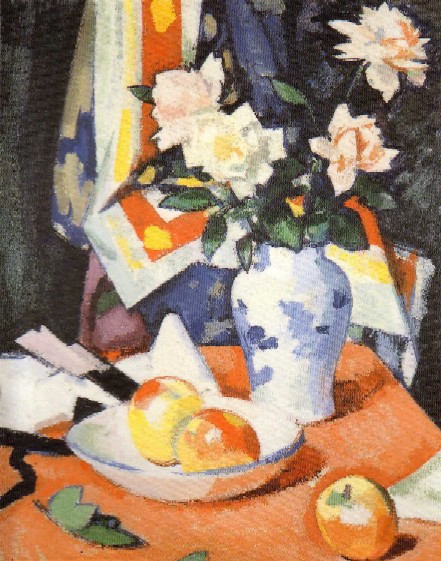20 November 2006
Across the Spectrum - Culture & Arts Forum event

The Culture & Arts Forum at the University of Dundee will take a journey `Across The Spectrumí on Wednesday November 22nd in a unique event examining the theme of Colour.
The wide ranging event will look at everything from the use of colour in films to the reasons why flamingoes are pink, along the way examining the "vulgarly vivid" nature of some of Scotlandís hidden architecture, the work of the Scottish `Colouristsí, and the development of colour photography.
"The programme shows just what an extraordinary range of different interests and activities take place around the University," said Matthew Jarron, Convenor of the Culture & Arts Forum. "Hopefully there'll be something here to appeal to everybody!"
The event brings together figures from various parts of the University including English, History, Fine Art, Geography, Botanic Gardens, Town & Regional Planning, Museum Services and Archive Services.
`Across The Spectrum' takes place in the University Tower Building, Perth Road, from 1.15 pm to 5.30 pm on Wednesday November 22nd. The event is free and all are welcome to attend.
To accompany the event an exhibition of colourful material from the University collections - from colourist paintings to brilliant butterflies - will be on show all week (until Saturday November 25th) in the foyer of the University Tower Building.
The University of Dundeeís Culture & Arts Forum is an informal group established in 2004 to aid communication and collaboration between the numerous parts of the University that are engaged in some form of cultural activity.
ACROSS THE SPECTRUM - Programme
Baxter Conference Room, Tower Building 1.15-5.30pm
1.15pm: Welcome
Caroline Brown (Secretary, Culture & Arts Forum)
1.25pm: Spectrum or Spectre - the illusion of Colour in the development of cinematography
Matthew Jarron (Museum Services)
Although we tend to think of colour being introduced to films in the 1930s, most silent films were coloured using an astonishing variety of different techniques. This presentation looks at the early development of colour, its aesthetic implications and how its (lack of) preservation has affected our understanding and appreciation of film history.
1.45pm: The Sudden Failing of Language
Moira Payne (Fine Art)
A pleasure that eludes description, the overwhelming experience of bliss. Within colour lies an understanding of a verbal visual resonance that describes a spiritual space.
2.00pm: Yellow and Blue donít make Green
Philippa Sterlini (Conservation Studio)
Pigments, dyes, media, discolouration, dirt, staining, acidity, UV and infra red light, L*A*B colour system, colour wheels and blue nitrile gloves - the colourful life of a conservator.
2.15pm: The Experience of Colour
Roger Young (Philosophy)
Objectively, colour may be a property of radiation or reflectance of light. However, one could know all about colour in an objective sense, but, if one had been born blind, one would not know what colour experience is like. Just what is involved in the knowledge of what the experience of (eg) vermilion is like?
2.30pm: Refreshments
3.00pm: It May Be Blue, But It's No Movie: Derek Jarman's Blue
Brian Hoyle (English)
Derek Jarman's final film, Blue, a meditation on AIDS and the director's own mortality remains controversial less for its subject than its form. Presenting the viewer with an unchanging blue screen for 75 minutes, Blue has been dismissed as utter rubbish and championed as a masterpiece that challenged notions of cinematic representation.
3.15pm: Seen Gardyneís Land lately?
Neil Grieve (Town & Regional Planning)
The bright colours of the Great Hall at Stirling Castle came as a surprise to many. This talk explores how colour is added to buildings, and will include a lively demonstration of how limewash is made.
3.30pm: Scared of Colour? Vividness or dourness in the Scottish architectural psyche
Charles McKean (History)
People consider that Scotland is a dour country with brown grey buildings entirely suitable to a Calvinist ethic - typical retrospective post-Victorian nonsense. Scotland was as vulgarly vivid as any European country, as this talk will show!
3.45pm: Why do trees look red? Remote sensing, colour and the natural environment
Mark Cutler (Geography)
A look at the way in which colour is used to map and monitor the natural environment from space.
4.00pm: Refreshments
4.20pm: Green Planet and Pink Flamingoes: why arenít plants black?
Neil Paterson (Botanic Gardens)
The physics of light and its interactions with pigments through evolutionary history explains the green colour of land plants and the colour changes of autumn leaves. Why land plants should be black but arenít and why flamingoes are pink are also explored.
4.35pm: History in Colour
Caroline Brown (Archive Services)
Tracing the development of colour photography, illustrated by items from the University Archive collections.
4.50pm: Colour in two and three dimensions: JD Fergusson's Painting and Sculpture
Jonathan Blackwood (Fine Art)
The Scottish artist John Duncan Fergusson is today remembered as the Ďleaderí of the Scottish Colourist painters. This short talk will discuss examples of both his painting and sculpture in terms of his use of colour, and the significance it had for him.
5.05pm: The Colour of Music
The Airlie Music Recorder Ensemble
A live performance of colourful music including The Silver Swan and The East is Red.
For media enquiries contact:
Roddy Isles
Head, Press Office
University of Dundee
Nethergate
Dundee, DD1 4HN
TEL: 01382 384910
E-MAIL: r.isles@dundee.ac.uk
| 
